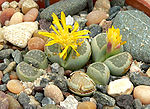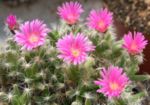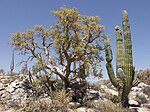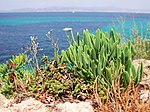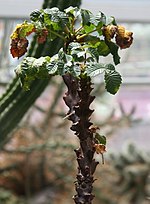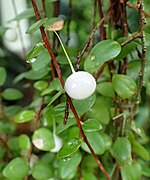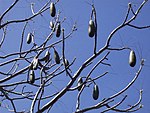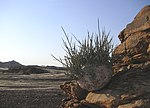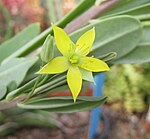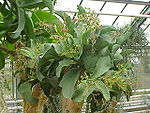Succulent plant
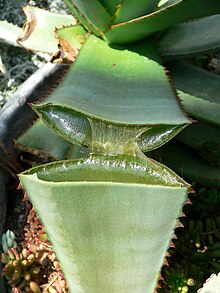
Succulents (singular the succulents, from the Latin sucus for 'juice' or suculentus for 'rich in juice') are plants rich in sap that are adapted to special climatic and soil conditions. Depending on the plant organ that has been transformed to store water, a distinction is made between leaf, stem and root succulents, all combinations being possible. In the field of anatomy , fluid-rich tissue is referred to as succulent.
Although cacti only make up a very small part of all existing succulents, they are considered the most famous representatives of the succulent plants. In linguistic usage, a distinction is therefore made between cacti and “other” succulents.
Due to the very different degrees of succulence in the individual species, an exact distinction between succulent and non-succulent species is sometimes very difficult. Succulent and non-succulent specimens can even occur within a species. At the borderline there are both herbaceous or woody plants as well as those that store sugar and starch rather than water in their beet roots. Succulents are sometimes referred to as fat plants .
Families and genera
Plant families and genera that contain succulents are listed in the table below. In order to keep the table clear and legible, all families and genera are listed alphabetically according to their botanical name and supplemented with the German common names of the families, if available. At this point, the German generic names, the authors of the taxa as well as information on synonyms and other hierarchical levels of the biological systematics (such as subfamilies), which can be found in the individual articles, are not taken into account .
literature
- Urs Eggli (ed.): Succulent lexicon. Monocotyledons . Eugen Ulmer, Stuttgart 2001, ISBN 3-8001-3662-7 .
- ↑ Agavaceae, pp. 1–103, 6 genera
- ↑ Anthericaceae, pp. 236-237, 1 genus
- ↑ Amaryllidaceae, pp. 232-236, 5 genera
- ↑ Araceae, pp. 238-239, 1 genus
- ↑ Asparagaceae, pp. 239-241, 1st genus
- ↑ Dracaenaceae, pp. 269–284, 3 genera
- ↑ Eriospermaceae, pp. 284-285, 1 genus
- ↑ Nolinaceae, pp. 299-306, 4 genera
- ↑ Aloaceae, pp. 103-231, 6 genera, 12 hybrid genera
- ↑ Asphodelaceae, pp. 241-256, 2 genera
- ↑ Bromeliaceae, pp. 256-257, only mentioned, no genera described
- ↑ Commelinaceae, pp. 257-265, 5 genera
- ↑ Dioscoreaceae, pp. 265-268, 1 genus
- ↑ Doryanthaceae, pp. 268-269, 1st genus
- ↑ Hyacinthaceae, pp. 286-299, 15 genera
- ↑ Orchidaceae, pp. 306–307, only mentioned, no genera
- ↑ Xanthorrhoeaceae, p. 307, Xanthorrhoea only mentioned, no genera
- Urs Eggli (ed.): Succulent lexicon. Dicotyledons (dicotyledons) . Eugen Ulmer, Stuttgart 2002, ISBN 3-8001-3915-4 .
- ↑ Anacardiaceae, pp. 3-4, 2 genera
- ↑ Araliaceae, pp. 13-14, 1 genus
- ↑ Balsaminaceae, p. 42, 1 genus
- ↑ Basellaceae, pp. 43-44, 2nd genus
- ↑ Begoniaceae, pp. 45-47, 1 genus
- ↑ Brassicaceae, pp. 52-55, 2 genera
- ↑ Burseraceae, pp. 56–61, 3 genera
- ↑ Campanulaceae, p. 63, 1st genus
- ↑ Caricaceae, pp. 65-67, 2 genera
- ↑ Convolvulaceae, pp. 69–74, 3 genera
- ↑ Didiereaceae, pp. 99-101, 4 genera
- ↑ Ericaceae, p. 102, 1st genus
- ↑ Fabaceae, pp. 244-252, 6 genera
- ↑ Fouquieriaceae, pp. 253-255, 1 genus
- ↑ Gesneriaceae, pp. 290–305, 8 genera
- ↑ Icacinaceae, pp. 305-306, 1 genus
- ↑ Lamiaceae, pp. 307-326, 7 genera
- ↑ Loasaceae, pp. 327-328, 1 genus
- ↑ Loranthaceae, pp. 328-329, 1 genus
- ↑ Melastomataceae, pp. 329-330, 1 genus
- ↑ Meliaceae, pp. 330-331, 1 genus
- ↑ Menispermaceae, pp. 332-334, 3 genera
- ↑ Moraceae, pp. 334-345, 2 genera
- ↑ Oxalidaceae, pp. 355-358, 1 genus
- ↑ Passifloraceae, pp. 359-374, 1 genus
- ↑ Pedaliaceae, pp. 374–385, 3 genera
- ↑ Phytolaccaceae, pp. 385-386, 1st genus
- ↑ Piperaceae, pp. 386-394, 1 genus
- ↑ Rubiaceae, pp. 464-472, 7 genera
- ↑ Sapindaceae, p. 473, 1st genus
- ↑ Urticaceae, pp. 478-481, 4 genera
- ↑ Vitaceae, pp. 482–494, 2 genera
- Focke Albers, Ulli Meve (ed.): Succulent lexicon. Asclepiadaceae (milkweed family) . Eugen Ulmer, Stuttgart 2002, ISBN 3-8001-3982-0 .
- Urs Eggli (ed.): Succulent lexicon. Crassulaceae (thick leaf family) . Eugen Ulmer, Stuttgart 2003, ISBN 3-8001-3998-7 .
- Heidrun EK Hartmann (eds.): Illustrated Handbook of Succulent Plants: Aizoaceae AE . Springer Verlag, Berlin / Heidelberg / New York 2001, ISBN 3-540-41691-9 .
- Heidrun EK Hartmann (eds.): Illustrated Handbook of Succulent Plants: Aizoaceae F-Z . Springer Verlag, Berlin / Heidelberg / New York 2001, ISBN 3-540-41723-0 .
- Edward F. Anderson: The Great Cactus Lexicon . Eugen Ulmer KG, Stuttgart 2005, ISBN 3-8001-4573-1 .
Individual evidence
- ^ Entry "Succulents" in the Duden online dictionary
- ^ Gerhard Wagenitz : Dictionary of Botany. The terms in their historical context. 2nd, expanded edition. Spektrum Akademischer Verlag, Heidelberg / Berlin 2003, ISBN 3-8274-1398-2 , p. 316.
further reading
- U. Eggli, R. Nyffeler: Living under temporarily arid conditions - succulence as an adaptive strategy . In: Bradleya . Volume 27, 2009, pp. 13-36.
- R. Nyffeler, U. Eggli: An up-to-date familial and suprafamilial classification of succulent plants . In: Bradleya . Volume 28, 2010, pp. 125-144.
Web links
- Cactus and succulent plant mall , German language website Internet hub with thousands of other links to succulent plants
- Specialist Society for Other Succulents
- Succulents Collection Zurich


